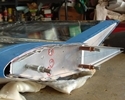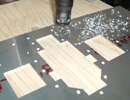


random user submitted photo
JPI EDM350 - My Experience
1 post
• Page 1 of 1
JPI EDM350 - My Experience
I figured I'd share my experience with my JPI EDM350 engine monitor.
I was looking for an inexpensive engine monitor for my Onex when re-doing the panel. I mostly considered either the MGL or the JPI. I ended up going with the JPI because several friends had good experience with certified JPI stuff. I ended up going with the JPI EDM-350 4 cylinder basic engine monitor (~$1000). The monitor came with 4 EGT probes and 4 bayonet style EGT probes. Thankfully, both cylinder and EGT probes were the same as the certified market. Thankfully, I was able to resell the cylinder probes to recoup some of the purchase cost. I don't recall exactly how much but I think I got $350 for the probes (I sold them to a friend).
My initial experience with JPI customer service started with trying to understand how the instrument is signaled for RPM. I contacted JPI telling them that I had a VW therefore the sensors they sell wouldn't work (because they mount on mags). The initial response from JPI was "our units only work with our sensors". I knew that we were both doing the same thing: counting how many times a magnet went by, therefore I knew that wasn't the full story. After several other attempts to contact JPI I got in touch with someone who assured me I could get the JPI tach to work with the Aerovee system, but they weren't exactly sure how. JPI's response: "You'll just have to play around and figure it out". I was able to make that happen but it wasn't the most reassuring sentiment.
On the temperature side, JPI uses type K thermocouples for just about every temperature measurement. This is really nice, as probes are super cheap. I wouldn't buy JPI probes for anything other than the EGT probes. JPI branded probes are all $80+, some even hundreds (for a thermocouple!!) I really do like how they mount the EGT probes, personally, I'd cut off the ring terminals they use for connectors and use standard thermocouple connectors, they're inexpensive, and easier to use and maintain.
Recently I've started doing engine runs and thus far everything has worked reasonably well. There is one interesting quirk to be aware of ahead of time: the engine monitor will not recognize a probe until there's a signal on the probe. This was confusing on the tachometer because the engine monitor wouldn't show the tachometer until the engine was running. In the end, it worked but threw me for a loop for a while. As a side note, if anyone else uses an EDM350 for an Aerovee, you need to set the #cylinders parameter to 24 to make the tach 1:1.
Now that the engine is running I wanted to take advantage of the real reason for having a digital engine monitor: data logging! JPI has free software for doing this, available for download from their website. I had issues with the software, it wouldn't install without a warning regarding Microsoft SQL error. After installation, I wasn't able to get any data off the engine monitor to work. I contacted JPI about this and sent them screenshots. JPI's response was less than confidence inspiring: "Yeah that's been happening a lot, just ignore it". I uninstalled and reinstalled the software, ignoring the error and have thus far been able to use the software. In my opinion, it's OK, it's mostly useful to convert files from the engine monitor to a .CSV file for use and analysis in Excel.
In summary, I went with the JPI because I heard they were known for quality. I'm happy with the quality of the hardware they supplied, the engine monitor itself is fine and it will likely do plenty for me for a while. Customer service from JPI is less than helpful; if you go down this route plan on being on your own. If I were able to do it all over again, I think I'd buy the MGL. I have no personal experience with MGL but it sounds like they're much more supportive and innovative.
I hope this helps, if anyone has a JPI instrument and you need help understanding how it works, hit me up and I can at least try to help you out.
-Chris
Onex #119
I was looking for an inexpensive engine monitor for my Onex when re-doing the panel. I mostly considered either the MGL or the JPI. I ended up going with the JPI because several friends had good experience with certified JPI stuff. I ended up going with the JPI EDM-350 4 cylinder basic engine monitor (~$1000). The monitor came with 4 EGT probes and 4 bayonet style EGT probes. Thankfully, both cylinder and EGT probes were the same as the certified market. Thankfully, I was able to resell the cylinder probes to recoup some of the purchase cost. I don't recall exactly how much but I think I got $350 for the probes (I sold them to a friend).
My initial experience with JPI customer service started with trying to understand how the instrument is signaled for RPM. I contacted JPI telling them that I had a VW therefore the sensors they sell wouldn't work (because they mount on mags). The initial response from JPI was "our units only work with our sensors". I knew that we were both doing the same thing: counting how many times a magnet went by, therefore I knew that wasn't the full story. After several other attempts to contact JPI I got in touch with someone who assured me I could get the JPI tach to work with the Aerovee system, but they weren't exactly sure how. JPI's response: "You'll just have to play around and figure it out". I was able to make that happen but it wasn't the most reassuring sentiment.
On the temperature side, JPI uses type K thermocouples for just about every temperature measurement. This is really nice, as probes are super cheap. I wouldn't buy JPI probes for anything other than the EGT probes. JPI branded probes are all $80+, some even hundreds (for a thermocouple!!) I really do like how they mount the EGT probes, personally, I'd cut off the ring terminals they use for connectors and use standard thermocouple connectors, they're inexpensive, and easier to use and maintain.
Recently I've started doing engine runs and thus far everything has worked reasonably well. There is one interesting quirk to be aware of ahead of time: the engine monitor will not recognize a probe until there's a signal on the probe. This was confusing on the tachometer because the engine monitor wouldn't show the tachometer until the engine was running. In the end, it worked but threw me for a loop for a while. As a side note, if anyone else uses an EDM350 for an Aerovee, you need to set the #cylinders parameter to 24 to make the tach 1:1.
Now that the engine is running I wanted to take advantage of the real reason for having a digital engine monitor: data logging! JPI has free software for doing this, available for download from their website. I had issues with the software, it wouldn't install without a warning regarding Microsoft SQL error. After installation, I wasn't able to get any data off the engine monitor to work. I contacted JPI about this and sent them screenshots. JPI's response was less than confidence inspiring: "Yeah that's been happening a lot, just ignore it". I uninstalled and reinstalled the software, ignoring the error and have thus far been able to use the software. In my opinion, it's OK, it's mostly useful to convert files from the engine monitor to a .CSV file for use and analysis in Excel.
In summary, I went with the JPI because I heard they were known for quality. I'm happy with the quality of the hardware they supplied, the engine monitor itself is fine and it will likely do plenty for me for a while. Customer service from JPI is less than helpful; if you go down this route plan on being on your own. If I were able to do it all over again, I think I'd buy the MGL. I have no personal experience with MGL but it sounds like they're much more supportive and innovative.
I hope this helps, if anyone has a JPI instrument and you need help understanding how it works, hit me up and I can at least try to help you out.
-Chris
Onex #119
Chris Higbee
Onex #119, Aerovee, Zenith, Prince 54/44
Tehachapi, CA
Onex #119, Aerovee, Zenith, Prince 54/44
Tehachapi, CA
- Chigbee
- Posts: 17
- Joined: Tue Aug 28, 2018 2:23 pm
- Location: Tehachapi CA (KTSP)
1 post
• Page 1 of 1
Return to Avionics and Instruments
Who is online
Users browsing this forum: No registered users and 43 guests







